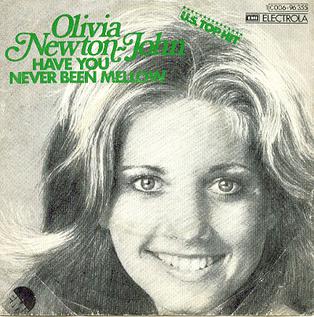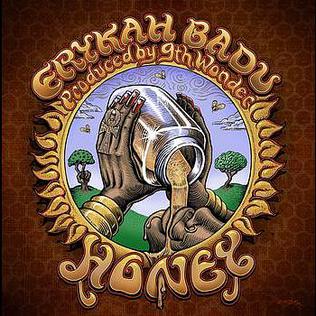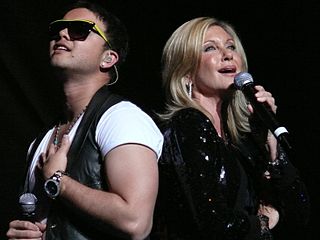
Dame Olivia Newton-John was a British and Australian singer and actress. She was a four-time Grammy Award winner whose music career included fifteen top-ten singles, including five number-one singles on the Billboard Hot 100 and two number-one albums on the Billboard 200: If You Love Me, Let Me Know (1974) and Have You Never Been Mellow (1975). Eleven of her singles and fourteen of her albums have been certified Gold by the Recording Industry Association of America (RIAA).
The Grammy Award for Best Music Video is an honor presented at the Grammy Awards, a ceremony that was established in 1958 and originally called the Gramophone Awards, to performers, directors, and producers of quality short form music videos. Honors in several categories are presented at the ceremony annually by the National Academy of Recording Arts and Sciences of the United States to "honor artistic achievement, technical proficiency and overall excellence in the recording industry, without regard to album sales or chart position".
The Grammy Award for Best Concept Music Video was an award that was presented to recording artists at the 30th Grammy Awards in 1988, and the 31st Grammy Awards in 1989, for quality, concept music videos. The Grammy Awards (Grammys) is an annual ceremony that was established in 1958 and was originally called the Gramophone Awards; awards are presented by the National Academy of Recording Arts and Sciences of the United States to "honor artistic achievement, technical proficiency and overall excellence in the recording industry, without regard to album sales or chart position".
The Grammy Award for Best Performance Music Video was an honor presented to recording artists at the 30th Grammy Awards in 1988 and the 31st Grammy Awards in 1989 for quality performance music videos. The Grammy Awards, an annual ceremony that was established in 1958 and originally called the Gramophone Awards, are presented by the National Academy of Recording Arts and Sciences of the United States to "honor artistic achievement, technical proficiency and overall excellence in the recording industry, without regard to album sales or chart position".
The Grammy Award for Best Pop Vocal Album is an honor presented at the Grammy Awards, a ceremony that was established in 1958 and originally called the Gramophone Awards, to recording artists for quality vocal pop music albums. Awards in several categories are distributed annually by the National Academy of Recording Arts and Sciences of the United States to "honor artistic achievement, technical proficiency and overall excellence in the recording industry, without regard to album sales or chart position."
The Grammy Award for Best Rap Performance is an honor presented to recording artists for quality rap performances. It was first presented at the 31st Annual Grammy Awards in 1989 and again at the 32nd Annual Grammy Awards in 1990, after which point the award was split into two categories: Best Rap Solo Performance and Best Rap Performance by a Duo or Group. These two categories were combined again in 2012 as a result of a restructure of Grammy categories, and the reinstated Award for Best Rap Performance was presented at the 54th Grammy Awards in 2012. The restructuring was the consequence of the Recording Academy's wish to decrease the number of categories and awards and to eliminate distinctions between solo and duo or group performances.
The Grammy Award for Best Female Rap Solo Performance was an honor presented to female recording artists at the 45th Grammy Awards in 2003 and the 46th Grammy Awards in 2004 for quality rap solo performances. The Grammy Awards, an annual ceremony that was established in 1958 and originally called the Gramophone Awards, are presented by the National Academy of Recording Arts and Sciences of the United States to "honor artistic achievement, technical proficiency and overall excellence in the recording industry, without regard to album sales or chart position".

"Physical" is a song recorded by British-Australian singer Olivia Newton-John for her 1981 eleventh studio album of the same name. It was released as the album's lead single on 28 September 1981. The song was produced by John Farrar and written by Steve Kipner and Terry Shaddick, who had originally intended to offer it to Rod Stewart. The song had also been offered to Tina Turner by her manager Roger Davies, but when Turner declined, Davies gave the song to Newton-John, another of his clients.
Elephant Parts is a collection of comedy sketches and music videos made in 1981 by Michael Nesmith, formerly of the Monkees. Nesmith produced the video through his company Pacific Arts. Elephant Parts is one hour long with parody commercials and comedy sketches, and features five full-length music videos, including the popular songs "Rio" and "Cruisin'", which featured wrestler Steve Strong and Monterey-based comic "Chicago" Steve Barkley.

Physical is the eleventh studio album by British-Australian singer Olivia Newton-John, released through MCA Records on 13 October 1981. The album was produced and partly written by her long-time record producer John Farrar. Recorded and mixed at Ocean Way and David J. Holman's studio in Los Angeles, Physical became one of Newton-John's most controversial and sexual records, and her most successful studio album. Musically, the album features considerable use of synthesizers, and it explores lyrical themes such as love and relationships, sex, and environmental protection. Upon its release, the album received positive reviews from music critics, many of them considering it to be Newton-John's best effort. The album charted high in several countries, including the United States, Japan and Newton-John's native Australia, becoming one of the most successful albums of the early 1980s. It also ranks among the best-selling albums by Australian solo artists, selling more than ten million copies worldwide.

Olivia's Greatest Hits Vol. 2 is the second greatest hits album by Olivia Newton-John released on 3 September 1982. The album compiled most singles released by Newton-John since the release of her 1977 Olivia Newton-John's Greatest Hits album from her following albums and soundtracks. The album included two new recordings; "Heart Attack" and "Tied Up", both of which were actually recorded during the sessions for the Physical album. It was released in the United Kingdom as Olivia's Greatest Hits.

"Hopelessly Devoted to You" is a song recorded by British-Australian singer, songwriter and actress Olivia Newton-John for Grease: The Original Soundtrack from the Motion Picture (1978). It was written and produced by John Farrar and originally performed by Newton-John in the film version of the musical Grease (1978). The song was released in Australia in August 1978 and peaked at number two. It reached number three on the US Billboard Hot 100 and number seven on the Adult Contemporary chart. On the country chart, "Hopelessly Devoted to You" peaked at number 20 and was her first top 20 country hit in two years. Newton-John performed the song at the 21st Grammy Awards in 1979.

"Have You Never Been Mellow" is a song recorded by British-Australian singer Olivia Newton-John for her 1975 fifth studio album of the same name. Written and produced by John Farrar, the song was released as the lead single from the album in January 1975.

"Honey" is a song by Erykah Badu, released on December 11, 2007, as the lead single from her 2008 album New Amerykah Part One . The song was produced by 9th Wonder and samples singer Nancy Wilson's 1978 song "I'm in Love".

Olivia Physical is a 1982 video collection featuring the singer Olivia Newton-John and various of her songs, most from the album Physical. A somewhat expanded version of the video was aired as an ABC prime-time television special, Let's Get Physical, which was in the top 10 of the Nielsen ratings. In 1983 the video received a Grammy Award as Video of the Year.

The videography of British-Australian singer-songwriter Olivia Newton-John consists of sixty-two music videos, three concert tour videos, four music video collections, two music video compilations, one TV special video and three promotional videos for television programs.

The Physical Tour was the fifth concert tour by Australian recording artist Olivia Newton-John, in support of her 12th studio album, Physical (1981). The tour primarily visited North America the second largest by Newton-John, visiting arenas and stadiums.

The singles discography of British-Australian recording artist Olivia Newton-John consists of 69 singles, three as a featured artist and 25 promotional recordings. She was a four-time Grammy award winner who amassed five number-one and ten other Top Ten Billboard Hot 100 singles, seven Top Ten Billboard Hot Country singles, and two number-one Billboard 200 solo albums. Ten of her singles topped Billboard's adult contemporary music singles chart. Eleven of her singles have been certified gold by the RIAA. She sold an estimated 100 million records worldwide, making her one of the world's best-selling artists of all time.












